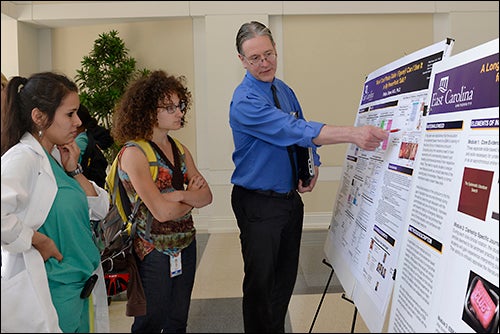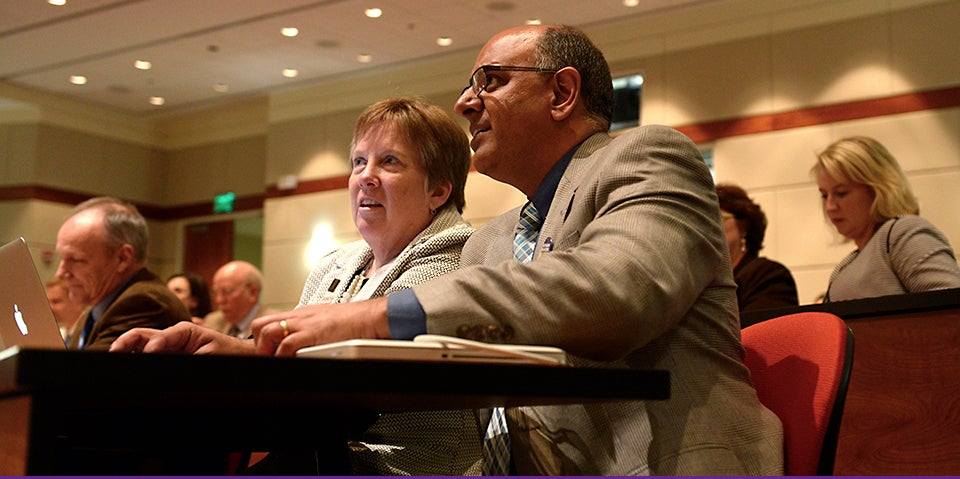LEARNING AND LEADING
Brody holds first Medical Education Day
Innovations in medical education were showcased and shared April 22 as health sciences faculty and learners from across East Carolina University gathered at the East Carolina Heart Institute at ECU to celebrate the Brody School of Medicine’s inaugural Brody Medical Education Day.
An offshoot of Brody’s $1 million, five-year grant from the American Medical Association to help reshape how future doctors are trained, the event was packed with posters and podium presentations. Topics ranged from patient safety and population health to working effectively in interprofessional teams.

ECU pathologist Dr. Philip Boyer explains his poster presentation during Medical Education Day at the East Carolina Heart Institute.
“Many imperatives for improving the effectiveness of our country’s health care system are not a consistent part of how medical students are being taught in the United States,” said Dr. Elizabeth Baxley, senior associate dean for academic affairs at Brody.
“As one of only 11 medical schools across the country chosen by the AMA to help reshape medical education, Brody is leading the way in developing a new curriculum that will better prepare physicians to work – and lead – within our evolving health care system.”
Keynote speaker Dr. Rajesh Mangrulkar, associate dean for medical school education at the University of Michigan – a fellow member of the AMA’s 11-school consortium – told attendees, “I am truly inspired by the exemplary work you are doing here to deliberately connect medical education to the health care system with meaningful projects. It is wonderful to see how your students and faculty are all participating in learning as well as leading.
“We are entering a period of profound change in our educational and health systems, and we have to be responsive,” Mangrulkar said. “Our institutions are not a lot alike, but we are on this journey together. We’re all at base camp and we can all see the summit. We’ll have to strategize our own different pathways to get there, but we can benefit from each other by sharing many of our best strategies with each other.”
Mangrulkar highlighted some of the University of Michigan’s efforts to address current challenges in medical education, including what he referred to as the “know-do gap,” the difficulty many learners have in translating the “explosion of basic science knowledge they get early on” into real-life clinical environments.
“Our goal is to bring science to the bedside earlier,” he said.
Mangrulkar also discussed his institution’s work to prioritize societal needs and population health. “Prevention and health maintenance typically get more lip service than action in med school,” he said, challenging listeners to consider whether learners should spend more time learning to care for hospitalized patients than learning to manage chronic disease.
Among those presenting educational projects at the event were the first graduating members of ECU’s Teachers of Quality Academy, a group of 27 selected health sciences faculty who spent the past 15 months immersed in the newest health system competencies, learning how to develop curricula and pioneering better ways to prepare future providers.
Several of these new educational components are already being integrated into the medical school curriculum at Brody, said Dr. Herb Garrison, associate dean for graduate medical education.
“You’ll see that these new approaches to teaching, research and leadership involve creating safer, more equitable and higher quality healthcare, improving the health of populations and working more effectively in interprofessional teams of health care providers,” Garrison said.
Emergency medicine physician and Teachers of Quality Academy graduate Dr. Tim Reeder said, “This day is the culmination of a lot of hard work to develop new educational components that will educate students from all disciplines. Although I’ve taught for many years, I’m thinking differently about how I teach now. It’s about critical thinking rather than rote memorization now.
“We’ve practiced in interprofessional teams for a long time,” Reeder added. “But there’s a recognition now that we need to educate in ways that support that.”
